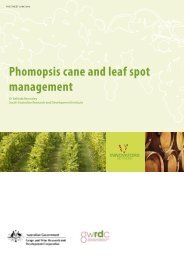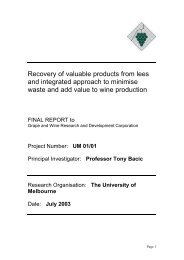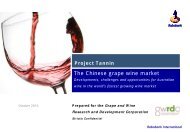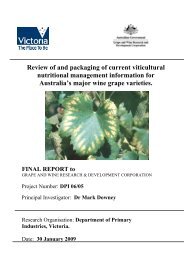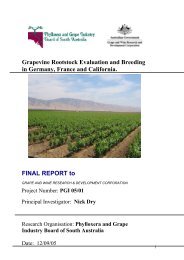Identification of the major drivers of 'phenolic' taste in ... - GWRDC
Identification of the major drivers of 'phenolic' taste in ... - GWRDC
Identification of the major drivers of 'phenolic' taste in ... - GWRDC
Create successful ePaper yourself
Turn your PDF publications into a flip-book with our unique Google optimized e-Paper software.
AWRI: <strong>Identification</strong> Of The Major Drivers Of ‘Phenolic’ Taste In White W<strong>in</strong>es<br />
measures <strong>of</strong> heat are <strong>in</strong>deed generally suppressed by <strong>the</strong> presence <strong>of</strong> phenolics, <strong>in</strong>clud<strong>in</strong>g caftaric acid.<br />
This shows that, <strong>in</strong> <strong>the</strong> absence <strong>of</strong> variations to matrix composition, phenolics may allow w<strong>in</strong>emakers to<br />
‘dial down’ white w<strong>in</strong>e hotness <strong>in</strong> some circumstances.<br />
Bitterness was, however, generally shown to be positively associated with phenolics. However, <strong>the</strong> two<br />
<strong>major</strong> phenolics <strong>in</strong> Australian white w<strong>in</strong>es (GRP and caftaric acid) do not contribute to bitterness. This<br />
means some o<strong>the</strong>r phenolic or phenolic class <strong>in</strong> white w<strong>in</strong>e does, but <strong>the</strong>ir identity rema<strong>in</strong>s unknown.<br />
However, various correlative studies consistently implicated flavanol and glycosylated flavonols as<br />
candidates for <strong>the</strong>se bitter tast<strong>in</strong>g compounds.<br />
Observations from w<strong>in</strong>emak<strong>in</strong>g treatments <strong>in</strong> 2010 show that, as anticipated, <strong>in</strong>creased sk<strong>in</strong> contact<br />
<strong>in</strong>creases phenolics <strong>in</strong> <strong>the</strong> w<strong>in</strong>es. However, somewhat unexpectedly astr<strong>in</strong>gency decreased and viscosity<br />
<strong>in</strong>creased and this is mostly due to <strong>the</strong> pH <strong>in</strong>crease (caused by potassium extraction from sk<strong>in</strong>s).<br />
Therefore, <strong>the</strong> desired phenolic outcome <strong>of</strong> any given w<strong>in</strong>emak<strong>in</strong>g treatment needs to be carefully<br />
considered from <strong>the</strong> perspective <strong>of</strong> <strong>the</strong> concomitant effect <strong>of</strong> pH on astr<strong>in</strong>gency and viscosity.<br />
Observations from w<strong>in</strong>emak<strong>in</strong>g treatments <strong>in</strong> 2011 (which were adjusted to similar pH’s) show that sk<strong>in</strong><br />
contact before and dur<strong>in</strong>g fermentation did not generally differ much <strong>in</strong> ‘phenolic <strong>taste</strong>’ compared to<br />
w<strong>in</strong>es made from whole bunch pressed, free run or hyper-oxidised w<strong>in</strong>es despite large differences <strong>in</strong><br />
phenolics.<br />
Overall, <strong>the</strong> notion that all phenolic compounds necessarily contribute to phenolic <strong>taste</strong>s should be re-<br />
exam<strong>in</strong>ed <strong>in</strong> <strong>the</strong> light <strong>of</strong> our f<strong>in</strong>d<strong>in</strong>gs that some ei<strong>the</strong>r do not affect <strong>taste</strong>s normally associated with <strong>the</strong><br />
presence <strong>of</strong> phenolics (i.e. bitterness), or <strong>in</strong>deed caused decreases <strong>in</strong> o<strong>the</strong>rs (i.e. astr<strong>in</strong>gency).<br />
Fur<strong>the</strong>rmore, pH, acidity, and alcohol levels impact strongly on how phenolics manifest <strong>the</strong>mselves <strong>in</strong><br />
<strong>taste</strong> and texture. At low alcohol levels typical <strong>of</strong> lighter bodied white w<strong>in</strong>es, phenolics contributed to<br />
<strong>the</strong>se <strong>taste</strong>s and textures, but at higher alcohol levels <strong>the</strong>ir impact was less apparent. Therefore,<br />
<strong>in</strong>terpretation <strong>of</strong> <strong>the</strong> possible sensory impact <strong>of</strong> phenolics <strong>in</strong> lighter bodied white w<strong>in</strong>es requires<br />
consideration <strong>of</strong> <strong>the</strong> underly<strong>in</strong>g matrix, particularly pH and alcohol levels.<br />
Implications for broader <strong>in</strong>dustry practices<br />
The Australian w<strong>in</strong>e <strong>in</strong>dustry has been receptive <strong>of</strong> new varieties and <strong>the</strong> uptake <strong>of</strong> novel processes <strong>in</strong> <strong>the</strong><br />
pursuit <strong>of</strong> new w<strong>in</strong>e styles. The recent surge <strong>in</strong> <strong>the</strong> plant<strong>in</strong>g and production <strong>of</strong> P<strong>in</strong>ot G to <strong>the</strong> po<strong>in</strong>t where<br />
it is now a commercially important variety <strong>in</strong> <strong>the</strong> Australian market is testimony to this. P<strong>in</strong>ot G. and<br />
o<strong>the</strong>r emerg<strong>in</strong>g varieties present a new challenge for Australian w<strong>in</strong>emakers, as arguably <strong>the</strong> phenolics<br />
derived from <strong>the</strong> grape play a <strong>major</strong> role <strong>in</strong> def<strong>in</strong><strong>in</strong>g <strong>the</strong>ir overall structure and style.<br />
Relatively high levels <strong>of</strong> phenolics (equivalent to <strong>the</strong> total phenolics encountered <strong>in</strong> w<strong>in</strong>es made from<br />
hard press<strong>in</strong>gs) when added to a light bodied w<strong>in</strong>e were shown to <strong>in</strong>crease its astr<strong>in</strong>gency, bitterness and<br />
viscosity. However, <strong>the</strong> effect <strong>of</strong> <strong>the</strong> phenolics was dependent on <strong>the</strong> matrix. Add<strong>in</strong>g phenolics to a low<br />
96




